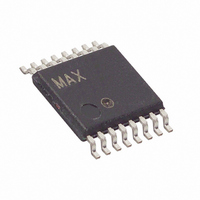DS2762BE+T&R Maxim Integrated Products, DS2762BE+T&R Datasheet - Page 20

DS2762BE+T&R
Manufacturer Part Number
DS2762BE+T&R
Description
IC MON BATT LI-ION HP 16-TSSOP
Manufacturer
Maxim Integrated Products
Datasheet
1.DS2762BE025TR.pdf
(25 pages)
Specifications of DS2762BE+T&R
Function
Battery Monitor
Battery Type
Lithium-Ion (Li-Ion)
Voltage - Supply
2.5 V ~ 5.5 V
Operating Temperature
-40°C ~ 85°C
Mounting Type
Surface Mount
Package / Case
16-TSSOP
Lead Free Status / RoHS Status
Lead free / RoHS Compliant
DS2762 High-Precision Li+ Battery Monitor With Alerts
NET ADDRESS COMMANDS
Once the bus master has detected the presence of one or more slaves, it can issue one of the net address
commands described in the following paragraphs. The name of each ROM command is followed by the 8-bit
opcode for that command in square brackets. Figure 17 presents a transaction flowchart of the net address
commands.
Read Net Address [33h or 39h]. This command allows the bus master to read the DS2762’s 1-Wire net address.
This command can only be used if there is a single slave on the bus. If more than one slave is present, a data
collision occurs when all slaves try to transmit at the same time (open drain produces a wired-AND result). The
RNAOP bit in the status register selects the opcode for this command, with RNAOP = 0 indicating 33h, and
RNAOP = 1 indicating 39h.
Match Net Address [55h]. This command allows the bus master to specifically address one DS2762 on the 1-Wire
bus. Only the addressed DS2762 responds to any subsequent function command. All other slave devices ignore
the function command and wait for a reset pulse. This command can be used with one or more slave devices on
the bus.
Skip Net Address [CCh]. This command saves time when there is only one DS2762 on the bus by allowing the
bus master to issue a function command without specifying the address of the slave. If more than one slave device
is present on the bus, a subsequent function command can cause a data collision when all slaves transmit data at
the same time.
Search Net Address [F0h]. This command allows the bus master to use a process of elimination to identify the
1-Wire net addresses of all slave devices on the bus. The search process involves the repetition of a simple three-
step routine: read a bit, read the complement of the bit, then write the desired value of that bit. The bus master
performs this simple three-step routine on each bit location of the net address. After one complete pass through all
64 bits, the bus master knows the address of one device. The remaining devices can then be identified on
®
additional iterations of the process. See Chapter 5 of the Book of DS19xx iButton
Standards for a comprehensive
discussion of a net address search, including an actual example (www.maxim-ic.com/iButtonBook).
SWAP [AAh]. SWAP is a ROM level command specifically intended to aid in distributed multiplexing applications
and is described specifically with regards to power control using the 27xx series of products. The term power
control refers to the ability of the DS2762 to control the flow of power into or out the battery pack using control pins
DC and CC . The SWAP command is issued followed by the net address. The effect is to cause the addressed
device to enable power to or from the system while simultaneously (break-before-make) deselecting and powering
down (SLEEP) all other packs. This switching sequence is controlled by a timing pulse issued on the DQ line
following the net address. The falling edge of the pulse is used to disable power with the rising edge enabling
power flow by the selected device. The DS2762 recognizes a SWAP command, device address, and timing pulse
only if the SWEN bit is set.
FUNCTION COMMANDS
After successfully completing one of the net address commands, the bus master can access the features of the
DS2762 with any of the function commands described in the following paragraphs and summarized in Table 3. The
name of each function is followed by the 8-bit opcode for that command in square brackets.
Read Data [69h, XX]. This command reads data from the DS2762 starting at memory address XX. The LSb of the
data in address XX is available to be read immediately after the MSb of the address has been entered. Because
the address is automatically incremented after the MSb of each byte is received, the LSb of the data at address XX
+ 1 is available to be read immediately after the MSb of the data at address XX. If the bus master continues to read
beyond address FFh, the DS2762 outputs logic 1 until a reset pulse occurs. Addresses labeled “Reserved” in the
memory map contain undefined data. The read data command can be terminated by the bus master with a reset
pulse at any bit boundary.
iButton is a registered trademark of Dallas Semiconductor.
20 of 25














